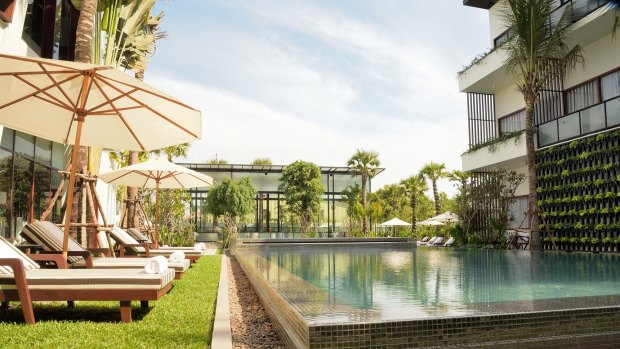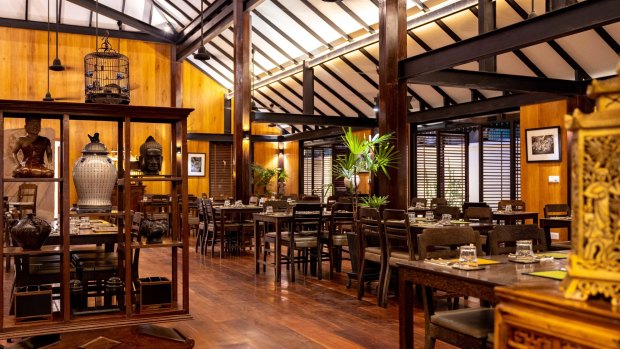This was published 4 years ago
Once backpacker central, Cambodia's Siem Reap is going upmarket
By Mark Orwoll

Jaya House Angkor Park hotel.
Street 30, in the northern reaches of Siem Reap, Cambodia, is the antithesis of hip, a quotidian neighbourhood of cafes, hardware stores, uniformed schoolkids on bicycles and locals in smoky tuk-tuks.
It's the complete opposite of the downtown area with its Pub Street nightclubs, tourist-menu restaurants and shops selling "I Love Cambodia" T-shirts. Yet Street 30 is home to one of Siem Reap's most anticipated luxury hotel openings, Jaya House Angkor Park, a harbinger of the city's future.
On a hard-hat tour not long before the hotel's launch, I'm impressed by the overall design and planning. The 31-room, five-star boutique, which debuted in January, has a quasi-art deco facade, full-service spa with five treatment rooms, two startlingly pretty chrome-tiled swimming pools, a glass-house restaurant, lush gardens, and an interior design that celebrates the apogee of cool Khmer culture in the 1960s.

The Sugar Palm restaurant, which serves up a highly memorable take on amok, a traditional Cambodian dish. Credit: Taste Siem Reap
In keeping with the management's commitment to the environment and the local economy, laundry bags are made by the nonprofit Rehash Trash using recycled plastic bags, creating full-time jobs for 14 women.
Angkor Park is also one of the closest luxe hotels to the famed temple ruins of Angkor Wat. But more interesting than all that is what Jaya House Angkor Park represents in a larger sense: the city's transformation from a haven for roving backpackers and short-term sightseers into a cultural hub of south-east Asia.
Christian de Boer, the Dutch-born managing director of Jaya House Angkor Park and its nearby sister, Jaya House River Park, which opened in 2016, is enamoured of Cambodian culture in the 1960s – its music, its art, its lifestyle.
"It was a free, creative time in this country," he says, knowing full well how short-lived that era was. Later came the dark years, the Vietnam War, the genocide by the Khmer Rouge and a war with Vietnam that ended 1989.
Creative and carefree are not words that come readily to mind when one thinks of Cambodia's recent history, but they're increasingly a part of it now. To get a better sense of how the past is over and the future is now, I take a couple of tours offered by UK tour operator Wild Frontiers and hope that will help me better understand how the city is changing.
That's how I meet Irish-born Robina Hanley in the lobby of the Jaya House River Park. Hanley is the owner of an art gallery and founder of Siem Reap Art Tours, which she created to introduce the city's fast-growing creative community to visitors. "This is for visitors who are here for more than two or three days and want to see more than just the temples," she says.
In a whirlwind afternoon tour, Hanley and I visit One-Eleven, the city's first international contemporary gallery, the home, gallery, and studio of Cambodian artist Lim Muy Theam, the mind-blowing workspace of Belgian painter Christian Develter and – an unexpected stop on an art tour – the atelier of Malagasy fashion designer Eric Raisina.
We browse through Raisina's ultra-chic retail boutique, meet some of the hand-stitch artisans upstairs and marvel at the industriousness of the silk weavers on the top floor with their medieval-looking looms.
Tall and elegant, Raisina is highly regarded for his novel use of silk and his patented "silk fur." As we arrive in his studio, the designer is scheduled to debut 32 pieces at a fashion show in Singapore just a few days later.
"I know all this looks stressful," he says, indicating the drawings on the messy work table, the employees passing by with bundles of fabric in their arms, "but it makes me so happy."
Beyond the world of art, Siem Reap's dining scene is reaching new heights, too. On a balmy evening I am the guest of Evi-Elli La Valle, whose company, Taste Siem Reap, organises dine-arounds at the city's most intriguing restaurants.
Our first stop, for appetisers, is Mie Cafe, where up-and-coming chef Pola Siv offers us beef laap (served raw after marinating in herbs, chilli, roasted sticky rice flour, and tomato sauce, and topped with red ants) in an elegant but relaxed setting. Later we have a dessert of creme brulee (made with rare Kampot peppercorns) in a stately white colonial-era manse, now Malis restaurant, home to Cambodian master chef Luu Meng.
But the highlight is our main course at The Sugar Palm, whose founder and chef, Kethana Dunnet ("the godmother of Cambodian cuisine," says La Valle) has developed a menu of dishes she learned to cook from her mother and grandmother while growing up in Phnom Penh.
We are delighted by Dunnet's take on amok, a traditional dish composed of chilli paste, kroeung (a paste of lemongrass, galangal, turmeric, kaffir lime, garlic and shallots), coconut cream, fresh eggs, shrimp paste, palm sugar, and snakehead, a whitefish whose lamentable name belies its flaky texture and mild taste.
I've had amok before and since, but this is an amok to be remembered, even more so as it is served in a restaurant that recalls a traditional Khmer home.
There is much more to my week in Siem Reap: a Cambodian cooking class at a farmland estate, a performance by Cambodian circus group Phare, a pensive visit to the Cambodia Landmine Museum, and an insider's bike tour of Angkor Wat's hidden temples.
But back at Jaya House River Park, where I am staying, I can't get my mind off the worldliness of Siem Reap. In the past week I have had a near-perfect martini at the hotel's open-air top-floor bar; admired the mix of knick-knacks and artefacts in the lobby saluting Cambodia's go-go '60s (including a 60-year-old "Grandphonic" TV, a Nippon Alpha radio, portraits of Khmer pop singers and ancient metal-bladed floor fans. I also had a massage in the spa by the dreamy pool. Yes, I think, modern is good.
The hotel's Christian de Boer is a motivator behind Siem Reap's cultural and touristic growth yet despite having revived an entire stretch of riverfront near his hotel with benches, lighting, and 1500 new trees, exhibits a Dutch reticence about his role. De Boer is also co-founder of Refill the World, a program in more than a dozen countries aiming to replace single-use plastic water bottles with refillable metal canisters.
I have to ask other people in order to find out that he pays for English lessons for all his Jaya House employees and provides them with food vouchers so that they receive proper nutrition, which is often beyond the budget constraints of locals.
He does not, however, have to teach his staff about politeness, charm, or how to smile, as it comes to them so easily. It's comforting to know that despite the laudable transformations going on in the city, some things do not change, and ideally never will.
Rooms at Jaya House Angkor Park are from $US169 a night which includes a daily spa treatment for each guest, transfers and breakfast.
Rooms at Jaya House River Park are from $US199 a night. See jayahouseriverparksiemreap.com
TOUR
Wild Frontiers organises a variety of tours in south-east Asia. See wildfrontierstravel.com
Siem Reap Art Tours and Taste Siem Reap have tours departing daily. See siemreaparttours.com; tastesiemreap.com
Mark Orwoll was a guest of Jaya House Hotels, with assistance from Wild Frontiers.
Sign up for the Traveller Deals newsletter
Get exclusive travel deals delivered straight to your inbox. Sign up now.